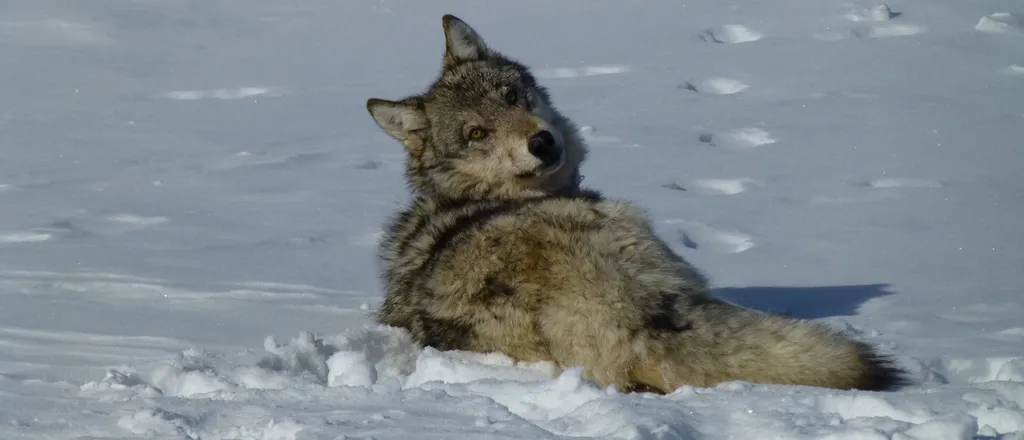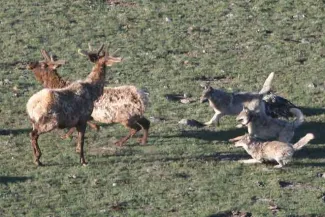
Three new wolf packs established in Colorado in 2025
Colorado’s voter-mandated program to reintroduce gray wolves took a big step forward in 2025 with the births of an unknown number new wolf pups in the spring, state wildlife officials confirmed this week.
Three new breeding pairs means the addition of three officially designated wolf packs — the One Ear pack in Jackson County, the King Mountain pack in Routt County, and the Three Creeks pack in Rio Blanco County — to Pitkin County’s Copper Creek pack, the only one established in the reintroduction program’s first year.

Colorado Parks and Wildlife
Colorado Parks and Wildlife officials have been monitoring the four wolf dens, but haven’t yet been able to confirm the exact number of pups born this year, they told agency commissioners Thursday. Movement tracking of collared wolves showed the den activity, and trail cameras placed near the den sites have captured photos and video of some of the pups. Wolf litters on average consist of about four or five pups, and half of those typically survive their first year of life.
“This reproduction is a really key point in the restoration of wolves to the state,” said Eric Odell, CPW’s wolf conservation program manager. “Despite some things that you may hear, not all aspects of wolf management have have been a failure.”
The Copper Creek pack was the first to be established after CPW began relocating gray wolves to the state in December 2023, but soon caused controversy with a series of livestock killings in Grand County. The pack was captured and relocated to Pitkin County last year, where one wolf, a yearling, was killed by wildlife agents in May after livestock depredations continued.
With the deaths of at least eight of the 25 wolves relocated to Colorado in the program’s first two years, survival rates fell below the 70% benchmark targeted by the state’s official restoration plan. Because of that, CPW officials said last month that the agency would review its “translocation protocols,” pending determinations of causes of death for each animal. But Odell told CPW commissioners Thursday not to expect big changes or the suspension of relocation efforts.
“What we can say is that none of those mortalities are due to any of the protocols from our capture efforts, from our transport from the source … or from our releases,” he said. “Importantly, there’s no reason justifiably to use this wolf mortality as a suggestion for pausing reintroduction.”
Compensation claims
CPW commissioners also held a lengthy hearing Thursday to settle two claims for compensation from livestock producers who suffered wolf depredations in 2024.
Farrell Livestock of Grand County and the Coberly Creek Ranch in Routt County were due to receive $287,407 and $66,807, respectively, in compensation for confirmed livestock deaths and reduced weights and conception rates. But the producers sought additional payments of $100,045 and $30,860, respectively, under an interpretation of state law that CPW’s legal counsel rejected.
Despite CPW’s recommendation that the additional claims be denied, commissioners voted 6-5 against denial, and then voted to settle with both producers for the full amount. Several commissioners said the body should move forward with a new rulemaking to provide clarity to the compensation structure moving forward.

Wolves hunting elk in the Rocky Mountains. Courtesy National Park Service.
Jeff Davis, CPW’s director, implied that awarding the full compensation claims would allow the agency to “keep (people) at the table and figure this out.”
“We have people that are losing hope. And when people lose hope, in my experience, they get desperate, and desperate things start to happen,” Davis told commissioners. “What I need is — and I’m not saying whatever decision you guys have to make, you’re the policymakers in this space — but I need to make sure that we’re delivering stuff that keeps people at the table, or we all will lose in this deal.”
Wildlife managers said problems with the Copper Creek pack in 2024 and 2025 are the exception rather than the rule, with most reintroduced wolves preying on native ungulates as they spread across the landscape on the Western Slope. As the new wolf packs establish well-defined territories, management and conflict mitigation will become easier, they said.
“It was never a supposition that wolves and livestock are going to get along great,” Odell said. “We knew that there was going to be conflict, we knew that there would be dead wolves, and we knew that there would be wolf reproduction. So these are all landmarks that are, that are important parts in the whole effort of wolf restoration.”
“Dealing with it certainly has proven challenging for producers, for CPW staff, for a variety of others, but it is a success,” he added. “I think we’re working towards success in many different ways, not just from a wolf population side of things, but from a producer perspective as well.”

















